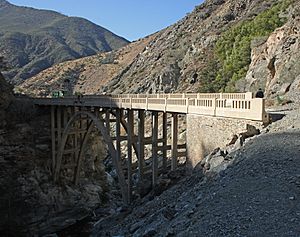Bridge to Nowhere (San Gabriel Mountains) facts for kids
Quick facts for kids Bridge to Nowhere |
|
|---|---|

The Bridge to Nowhere in the San Gabriel Mountains, Southern California
|
|
| Coordinates | 34°16′59″N 117°44′48″W / 34.28306°N 117.74667°W |
| Carries | Pedestrians |
| Crosses | San Gabriel River |
| Locale | San Gabriel Mountains, California |
| Characteristics | |
| Design | open spandrel arch |
| Clearance below | 120 feet (37 m) |
| History | |
| Opened | 1936 |
| Lua error in Module:Location_map at line 420: attempt to index field 'wikibase' (a nil value). | |
The Bridge to Nowhere is a unique arch bridge built in 1936. You can find it north of Azusa, California, nestled in the San Gabriel Mountains. This bridge stretches over the East Fork of the San Gabriel River. It was originally planned to be part of a road connecting the San Gabriel Valley to Wrightwood.
Contents
Why is it Called the Bridge to Nowhere?
The road leading to the bridge, called the East Fork Road, was still being built. Then, a huge flood hit in March 1938. This flood, known as the great flood of March 1–2, 1938, washed away parts of the road. Because of this, the road project was stopped. This left the bridge all alone in the middle of what is now the Sheep Mountain Wilderness. That's why it's called the "Bridge to Nowhere"!
You can still see bits of the old asphalt road today. They are along the East Fork Trail that goes to the bridge. There are also concrete pieces that were foundations for other bridges. These bridges were destroyed west of the Bridge to Nowhere.
Hiking the East Fork Trail
To reach the Bridge to Nowhere, you have to hike! It's a 10-mile round-trip journey. Even though many people visit, the trail can be rough. This is because floods often wash parts of it away.
The trail follows the riverbed. You will cross the East Fork of the river about six times. Usually, you walk along the river, which is often dry. Then, you climb up to reach the bridge.
Who Takes Care of the Trail?
The San Gabriel Mountains Trailbuilders are a group of volunteers. They are in charge of keeping the East Fork Trail safe and clear. They work with the United States Forest Service. These volunteers often fix the trail in winter. This is when snow makes it hard to work on higher trails.
The Trailbuilders do a lot of work. They carve steps into rocks to make hiking safer. They also clear away plants and rocks from the path. They even built a special bridge called the John Seals Bridge. They used helicopters and animals to bring in materials. This bridge helps hikers cross Laurel Gulch safely.
Trail Safety Alert
There is a large rockfall about 1.56 miles into the trail. It's a big pile of rocks that can be tricky to climb over. There are also more rocks that could fall. The United States Forest Service and the Trailbuilders are looking into this problem.
Sometimes, you might need to cross the river two extra times to get around the rockfall. This is usually only when the river has water. The riverbed is dry for most of the year.
Bungee Jumping at the Bridge
The Bridge to Nowhere is a private area within the Angeles National Forest. A private company offers Bungee jumping from the bridge. People who want to jump usually meet early in the morning. They gather at the Heaton Flats Campground parking area. Then, they walk together to the East Fork Trailhead. After jumping, people hike back. Some might even hike after dark.
Staying Safe on the River
The East Fork of the San Gabriel River can be dangerous. The water can flow very fast. It can also rise quickly without warning. This happens when heavy rain falls northeast of the area. These rains can cause sudden floods.
Crossing the river to and from the Bridge to Nowhere can be risky. Even groups of people have faced dangers here. Always be careful and aware of the water conditions.
Reporting Trail Problems
The San Gabriel Mountains Trailbuilders are responsible for the East Fork Trail. This includes the trail from Heaton Flats Campground through the Sheep Mountain Wilderness. It goes all the way to the bridge's leased land.
If you see problems on the trail, you can report them. This includes fallen trees, rockfalls, or bad erosion. You can report them on the Trail Repairs website. Or, you can call the United States Forest Service at the San Gabriel River Ranger District.

